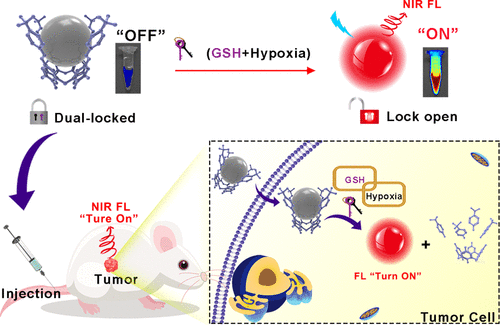Abstract
Stimulus-responsive fluorescent probes have broad applications in the early detection and treatment of tumors and thus promote the personalized treatment of tumors and improve patient survival. Among the repertoires of probes, dual-locked near-infrared (NIR) fluorescent probes are of great significance due to their improved specificity and multiplex detection in tumor imaging but remain to be explored. In this work, a facile noncovalent strategy for constructing dual-locked probes was proposed. A glutathione (GSH)-activatable single-locked probe CySS (first lock) was preloaded into a hypoxia-responsive molecular container CF3C4A (second lock) through a host-guest interaction to form the dual-locked probe CF3C4A-CySS. Under physiological conditions, CF3C4A-CySS binds strongly to avoid undesired leakage in normal tissues. We have proven that CF3C4A-CySS can be activated and "turn on" its NIR fluorescent signal under the dual key stimulation of hypoxia and GSH in the tumor microenvironment, which enables precise tumor imaging with enhanced accuracy and specificity. Both in vitro and in vivo results indicated the superiority of CF3C4A-CySS in tumor imaging. This work not only provides an effective tool for tumor imaging but also proposes a promising strategy for dual-locked imaging agent construction.

Keywords Plus:IN-VIVOCANCER-CHEMOTHERAPYRATIONAL DESIGNGLUTATHIONETRACKINGNANOPARTICLESHYPOXIA
Published in ANALYTICAL CHEMISTRY,Volume94;10.1021/acs.analchem.2c00406,MAY 3 2022


